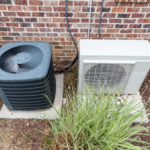blog


When it comes to cooling your home, you have many HVAC system equipment options. Many homeowners are familiar with traditional central air systems and heat pumps, but the ductless mini split is another option that is gaining traction in homes throughout the Inland Empire. Because you may not be as familiar with a ductless system, many people wonder, if it is more energy efficient? Sanborn’s Air Conditioning & Heating can answer all of your ductless system questions, so read on as we compare ductless systems to the traditional HVAC systems you’re used to.
What Are Ductless Mini Splits?
Before we get into why mini-split systems are more energy-efficient, we first need to share more information about them to give you a complete understanding. The design of a mini-split system is a bit different than what you’re used to if you have a traditional central air conditioner or heat pump.
A ductless mini-split system is a split system, meaning it has indoor and outdoor components – just like central air systems or heat pumps would. While a traditional split system has one indoor unit and one outdoor unit, a ductless mini-split has one outdoor unit that connects to multiple indoor units. Instead of one air handler routing conditioned air across the home through ducts, ductless mini splits use numerous air handling units to deliver cool air directly into a space.
Are Mini Split Systems More Efficient?
Do mini-splits have more energy efficiency than traditional central forced air systems? The answer is yes. Some key points about their design lend themselves to creating a more energy-efficient cooling system.
- The absence of ducts. Traditional ducted forced central air conditioning systems can lose energy through duct leaks. The average home loses as much as 20 to 30 percent of heating and cooling energy through these leaks. Mini-splits don’t use ducts – instead, heated or cooled air comes straight out of the handler and into the space, similar to window unit air conditioners. Without a ductless system, mini-splits can eliminate 20 to 30 percent of energy loss on average, increasing energy efficiency and reducing cooling costs.
- Zoned comfort. Because a handler is installed directly in various areas of the home, ductless mini-split systems offer the ability to zone the house and individually control heating and cooling needs. Each mini split handler is controlled independently of other units, even though they all use the same outdoor unit. Temperature can be adjusted in one particular room without impacting comfort in other parts of the home. With mini-splits, energy is only used when it is needed, where it is required. With a traditional cooling system, the entire home receives air conditioning even if you only need it in one room, which wastes energy.
Many mini-split systems are available with higher Seasonal Energy Efficiency Ratio (SEER) ratings than traditional air conditioners and heat pumps. Mini-split system equipment is available up to 42 SEER, while the highest rating air conditioners and heat pumps have SEER ratings in the mid-20s. Are these systems more energy efficient based on ratings and other design factors? The answer is a resounding yes!
Mini Split Installation
Are mini-splits more efficient than traditional central air conditioners and heat pumps? Hands down, yes, they are. If you need an efficient cooling system for your home, we urge you to consider the energy-saving benefits of a ductless mini-split system. Call Sanborn’s Air Conditioning & Heating today to receive a quote for system installation.